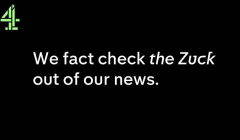
Channel 4’s fact checks the Zuck out of its news
The responsive campaign underlines the role of the news brand as a source of trusted news.

An impactful campaign hijacked back to school social posts to highlight the harsh realities for children in conflict


The concept behind UNHCR’s (United Nations High Commissioner for Refugees) latest fundraising campaign, devised by Jellyfish, is simple: co-opt the most frequently used hashtags on social networks to raise awareness about the startling daily lives of millions worldwide.
Sector
CharityBack to school is a key moment on the marketing calendar. Each September the start of a new school year brings with it a myriad of moments to connect, console and clothe both parents and children as enter a new stage of their journey.
A journey which is marked by photographs on doorsteps of fresh-faced children across the globe laden with new uniforms designed to be grown into and posted online beneath back-to-school hashtags.
It is a journey that is powerfully hijacked by the United Nations High Commissioner for Refugees (UNHCR’s) latest campaign, devised by Jellyfish.
The idea is both simple and impactful: take the most frequently used hashtags on social media to raise awareness about the harsh realities of life for children who won't be standing on doorsteps, but instead facing up to conflict and persecution.
The plight of uprooted people, forced to flee their homes because of conflict, persecution or climate change, deserves as much visibility as the millions of hashtag mentions.
THE NEED TO SHED LIGHT ON THE TOUGH REALITY OF MILLIONS
UNHCR's mission is to take international action to protect refugees, forcibly displaced communities and stateless people, so that everyone forced to flee can build a better future for themselves. While the organisation is very active in the field, particularly in relation to armed conflicts, as the general public has seen with the war in Ukraine, its actions don’t end there. And the realities are no less worrying.
More than 110 million people around the world are uprooted by war, persecution, violence and/or human rights violations. More than 130 countries and territories are affected. Today almost 10 billion euros are needed to save lives, improve the daily lives of refugees and displaced persons, and support them in building a brighter future.
Behind these staggering figures are people in real need. Hence the need to appeal, raise awareness and gather financial support from current and future donors.
The UNHCR has therefore commissioned the agency Jellyfish to create a new, visually striking communications campaign. "Behind the Hashtag" which began on the 23th August throughout France and will be visible until the end of the year.
BASED ON A FOUNDING PRINCIPLE: THE “HACKTAG”
The campaign was developed with social media in mind, using the most popular hashtags on Instagram. Built around four key moments, it creates a dissonance between what the hashtags conjure up, and the reality of millions of people around the world. This unexpected and disturbing association creates an emotional shock, tugging at the heartstrings. The addition of factual data reinforces the sense of urgency.
#SunnyDay has 55 million mentions on Instagram, often evoking holidays and the pleasure of soaking up the sun. It's also the number of people affected by droughts around the world.
#BackToSchool has 14 million mentions on Instagram, illustrating the start of the new school year and showing children happily reunited with their classmates. It's also the number of people waiting for humanitarian aid and protection in Syria.
#FamilyLove has nearly 8 million results showing loving families going about their daily routine. It also represents the number of uprooted families and children around the world.
#HomeSweetHome has almost 66 million results, expressing the happiness of being at home, of having a home. That's almost the number of people forcibly displaced within their own country.
The impact of the campaign is also owed to the geographical and temporal contextualisation of the messages via a creative online media plan (across landing pages, display, social media, emailing) and an offline media plan (DOOH, press and billboards). They are released in relevant locations (for example, the #SunnyDay creative is more powerful near train stations and airports) and over an appropriate period (for example, the #BackToSchool creative is more effective at the beginning of September for the start of the new school year).
"Our campaign has two key objectives: to raise awareness and to collect donations, which are needed more than ever to continue our work. The clever use of familiar hashtags to highlight urgent and worrying realities is a bold breakaway in our communications. Our powerful visuals and hard-hitting messages are being used near airports and at the start of the new school year to make a real impact. It's a game-changing campaign, skilfully orchestrated by our creative agency Jellyfish.” added Charlotte Pinet, Head of Private Sector Partnerships, UNHCR France
Looks like you need to create a Creativebrief account to perform this action.
Create account Sign inLooks like you need to create a Creativebrief account to perform this action.
Create account Sign in